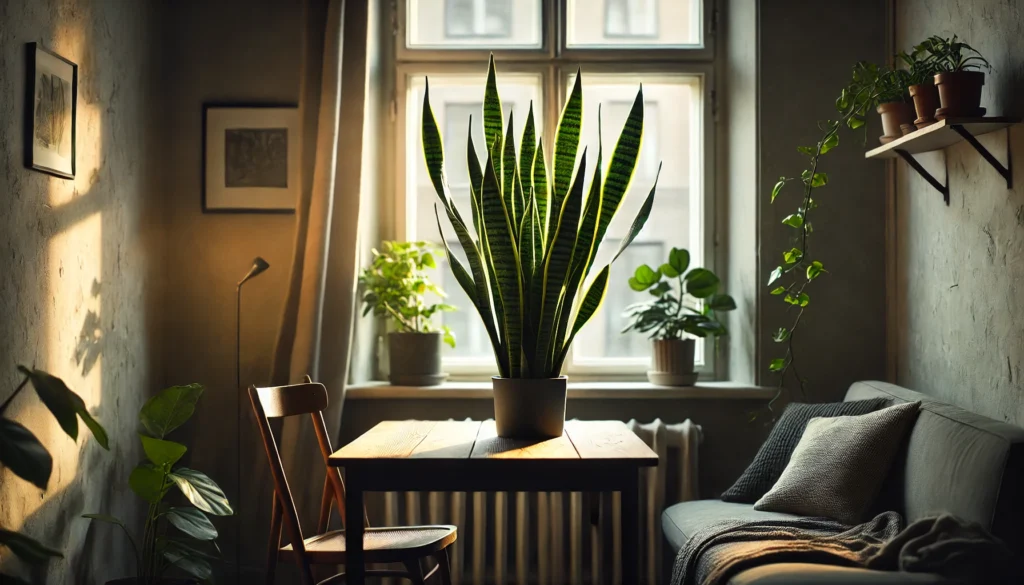
Snake Plant Care in Low-Light Conditions: Essential Tips for Thriving Growth
If you’re looking for a resilient, low-maintenance plant that thrives in less-than-ideal lighting, the snake plant is your perfect match. Known for its ability to survive in challenging environments, snake plant care in low-light conditions is easier than you might think. Whether you’re a beginner or a seasoned plant parent, this guide will walk you through everything you need to know to keep your snake plant healthy and vibrant, even in dimly lit spaces. Keep reading for essential tips that will help your snake plant thrive, no matter the lighting!
Table of Contents
ToggleUnderstanding the Snake Plant’s Natural Habitat
The snake plant (Sansevieria), also known as mother-in-law’s tongue, is native to West Africa, particularly in tropical and subtropical regions. It thrives in arid, rocky environments with well-drained soil, where it faces minimal rainfall and fluctuating temperatures. These conditions have shaped the plant’s unique adaptations, allowing it to thrive with little water and in low-light environments.
Key Aspects of its Natural Habitat
- Low Light: In the wild, snake plants often grow in shaded areas under trees, receiving indirect sunlight.
- Drought Tolerance: Due to its origin in dry regions, the snake plant has evolved to store water in its thick, upright leaves.
- Temperature: Snake plants prefer moderate temperatures (60–85°F or 15–29°C) and are sensitive to frost, which is why they do best in indoor environments.

Adaptations to Thrive in Harsh Conditions
The snake plant’s waxy leaf coating prevents water loss, while its deep roots allow it to survive extended dry periods. These unique characteristics make it one of the best low-maintenance plants for indoor environments. Understanding its natural habitat helps you replicate the conditions it thrives in, ensuring a long-lasting, healthy plant in your home.
Why Snake Plants Are Perfect for Low-Light Spaces
If you’re looking for a plant that thrives in low-light environments, the snake plant (also known as Sansevieria) is your best bet. This hardy plant is an ideal choice for beginners and those with spaces that don’t receive direct sunlight. Here’s why snake plants are perfect for low-light spaces:
Tolerates Low Light Conditions
Snake plants are incredibly adaptable. They can survive in areas with minimal natural light, making them ideal for rooms with small windows or no direct sunlight. They will still grow and thrive in these conditions, though they may grow slower than they would in brighter spaces.
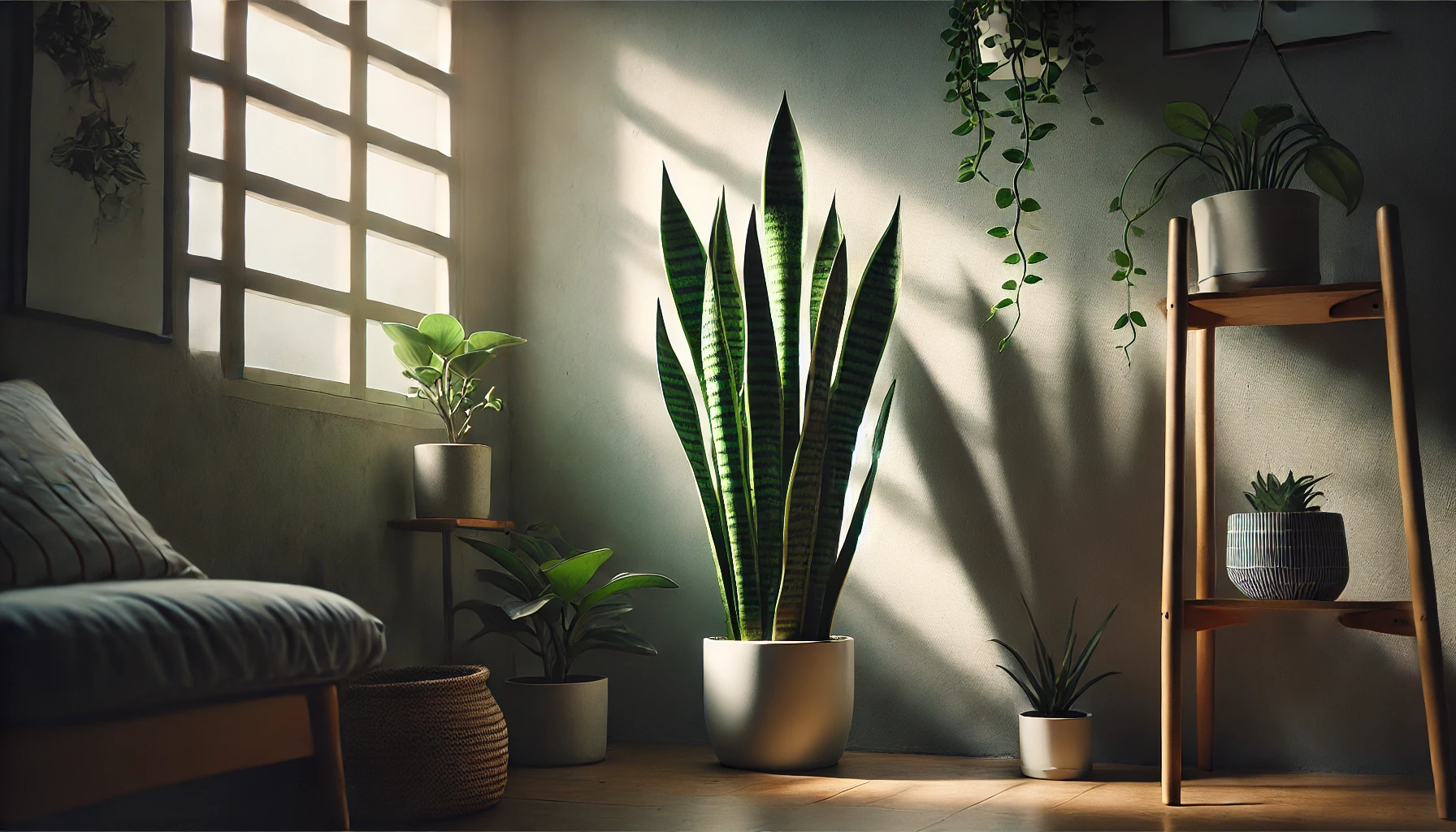
Minimal Watering Needs
Another reason snake plants excel in low-light spaces is their ability to store water in their thick, fleshy leaves. This means they don’t require frequent watering. In fact, overwatering is one of the most common mistakes people make with snake plants. Allow the soil to dry out completely between waterings, and they’ll be happy.
Air-Purifying Qualities
Snake plants are excellent air purifiers, making them a great addition to bedrooms, offices, or any room where you spend a lot of time. They help filter toxins like formaldehyde, benzene, and xylene, improving indoor air quality.
Low Maintenance
Snake plants are virtually care-free. They don’t need to be pruned regularly, and their slow-growing nature means they don’t require frequent repotting. Even with occasional neglect, snake plants will continue to flourish.
Unique Appearance
With their upright, sword-like leaves and striking patterns, snake plants add a touch of elegance to any space. Whether placed on a windowsill or in a corner, their modern, architectural look suits a variety of home décor styles.
Resilience
One of the standout features of snake plants is their resilience. They can bounce back from neglect, drought, and even low light, making them perfect for busy plant owners or those new to plant care.
Essential Tips for Snake Plant Care in Low-Light Conditions
Snake plants (Sansevieria) are a favorite among plant owners, especially for those with low-light spaces. They’re hardy, low-maintenance, and perfect for beginners. Here are essential care tips to keep your snake plant thriving, even in low light:
Understand Low-Light Tolerance
Snake plants are adaptable and can tolerate low-light environments, but they still need some indirect light to grow. Keep them near a window with filtered light or in a space with ambient light. While they can survive in very low light, they won’t thrive or grow as quickly.
Watering Wisely
One of the most common mistakes is overwatering. In low-light conditions, snake plants need less water because the soil takes longer to dry out.
- Water only when the soil is completely dry, typically every 2-3 weeks.
- Ensure the pot has good drainage to avoid root rot.
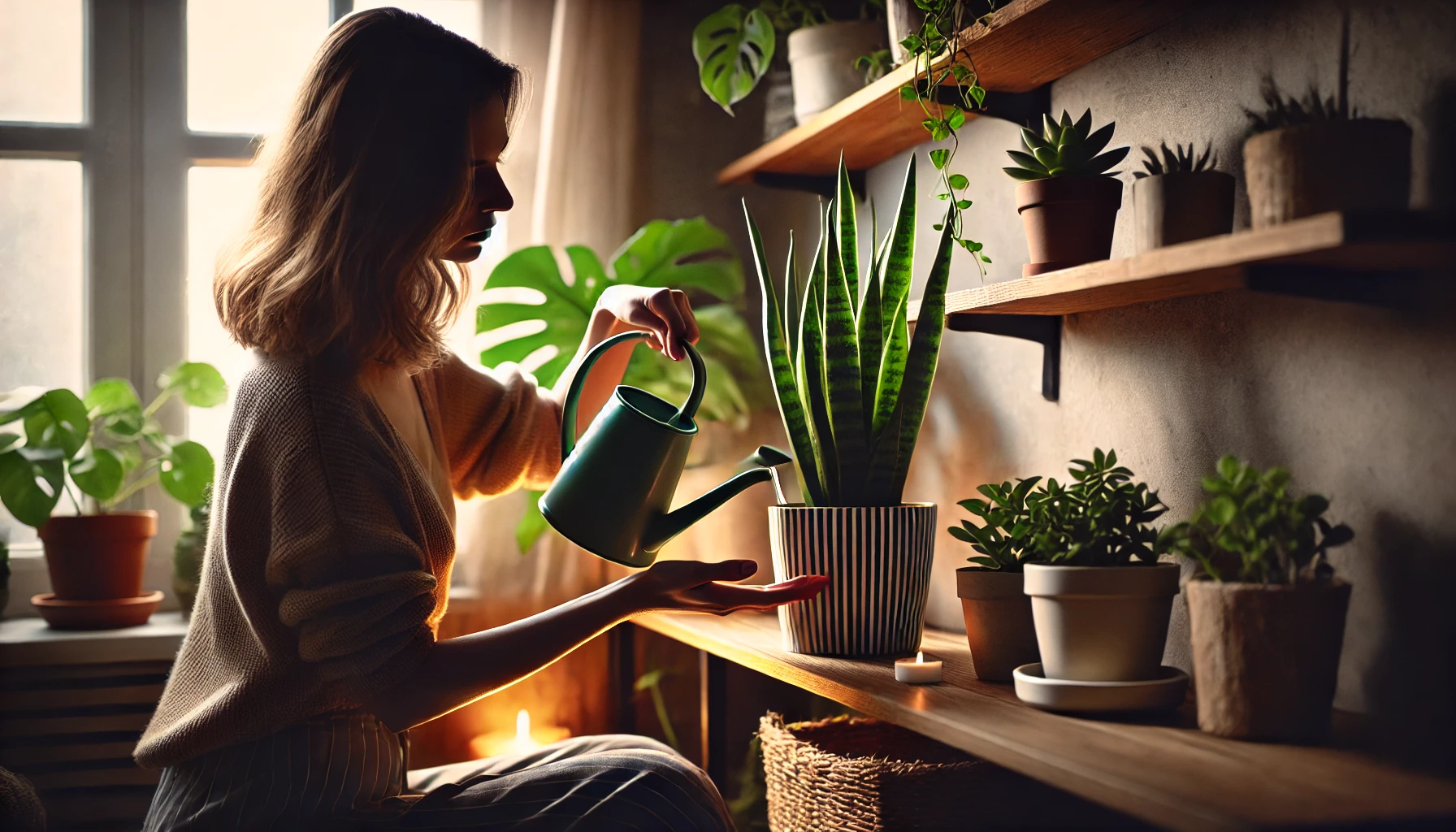
Use Well-Draining Soil
Even in low light, snake plants require well-draining soil. A cactus or succulent mix is ideal, or you can add perlite or sand to your regular potting mix. This helps prevent water from sitting around the roots and encourages healthy growth.
Maintain Proper Temperature
Snake plants prefer temperatures between 60–85°F (16–29°C). Avoid placing them near cold drafts or heat sources like radiators. Low temperatures or extreme heat can stress the plant and slow growth.
Limit Fertilizing
In low light, snake plants grow slowly, so they don’t need much fertilizer. Apply a balanced, diluted fertilizer during the growing season (spring and summer) once every 4-6 weeks. Avoid fertilizing in the fall and winter when the plant is dormant.
Be Patient with Growth
Snake plants are slow growers, especially in low-light conditions. You might not see much new growth, but this doesn’t mean your plant isn’t healthy. With time, it will adapt to its environment, so be patient and continue with the proper care routine.
Check for Pests
Even though snake plants are generally resistant to pests, it’s still a good idea to inspect the leaves regularly. Look for signs of mealybugs or spider mites, especially around the base of the plant. If you spot any pests, treat the plant with neem oil or an insecticidal soap.
Troubleshooting Common Issues in Low-Light Conditions
Plants in low-light conditions can thrive, but they may face specific challenges. Understanding these common issues and knowing how to address them can keep your plants healthy and happy.
Leggy Growth
Issue: When plants don’t get enough light, they stretch toward the light source, causing long, weak stems (known as leggy growth).
Solution: Move the plant closer to a light source or provide supplemental lighting with a grow light. Trim back the leggy stems to encourage bushier growth and remove any yellowing leaves.
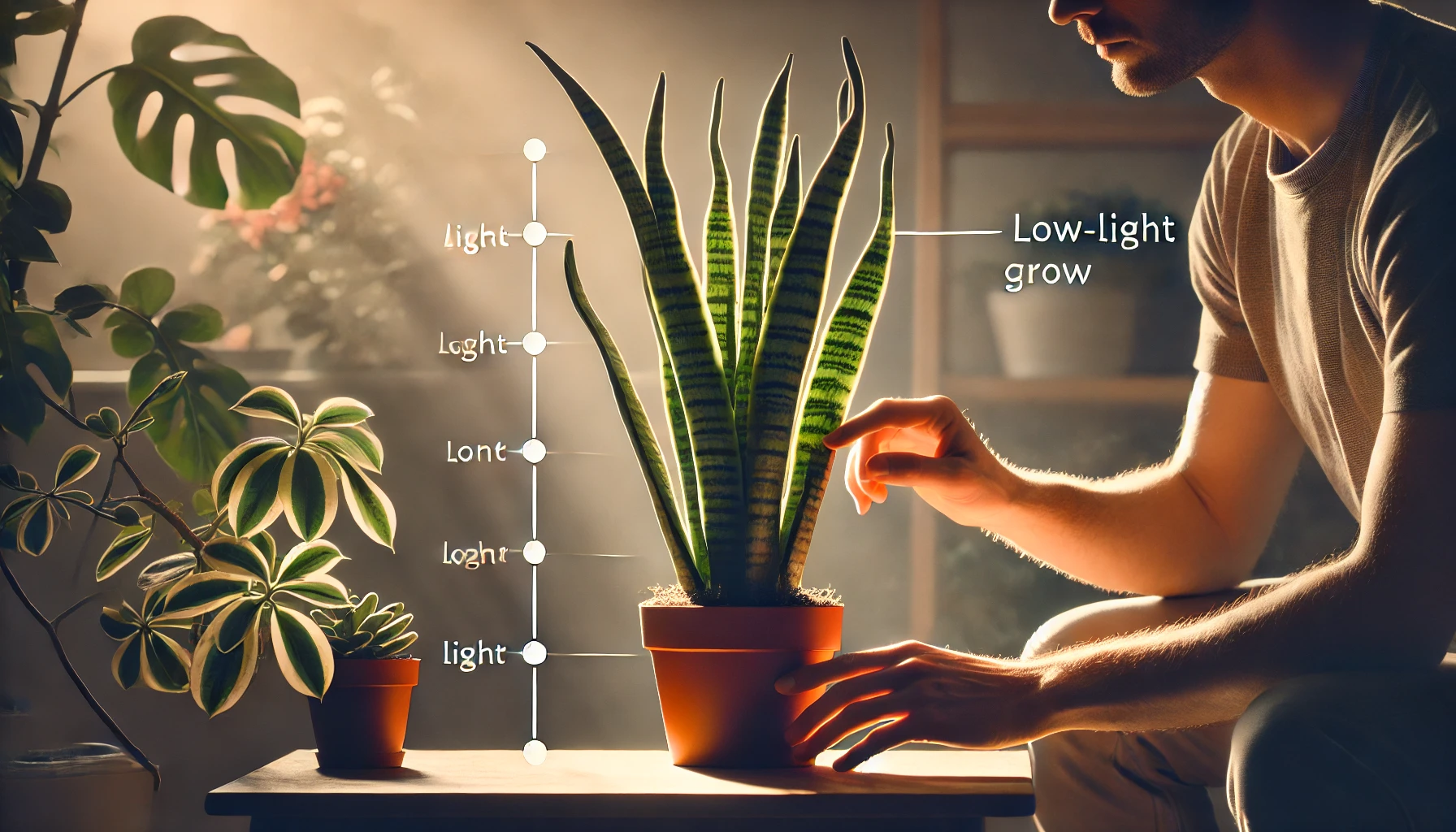
Yellowing Leaves
Issue: Yellowing leaves often occur when plants are not getting enough light or water.
Solution: Ensure the plant is in an appropriate spot with indirect light. For low-light plants, adjust watering frequency—only water when the top inch of soil feels dry. Remove yellow leaves to improve the plant’s overall appearance.
Slow Growth
Issue: In low-light conditions, plants naturally grow slower since they aren’t able to photosynthesize as efficiently.
Solution: Use a grow light if natural light is too limited. Additionally, consider fertilizing during the growing season to give the plant a boost. Be patient—slow growth is natural in low-light conditions.
Leaf Drop
Issue: Inadequate light can cause plants to shed their leaves as they struggle to survive.
Solution: Move the plant to a location with more indirect light or use a grow light to ensure it gets enough energy to maintain its leaves. Avoid overwatering, as this can also contribute to leaf drop.
Stunted Growth and Pale Leaves
Issue: When plants receive insufficient light, they may develop pale leaves and show stunted growth.
Solution: Ensure the plant is not in a completely dark corner. Even low-light plants need some light to stay healthy. Consider rotating your plants to ensure even light distribution or introduce artificial lighting to supplement.
Mold or Mildew
Issue: Low light, combined with high humidity, can lead to mold or mildew growth on your plants.
Solution: Improve airflow by spacing plants out or using a fan. Avoid overwatering and allow the soil to dry out between waterings. Ensure that the plant is not sitting in a waterlogged saucer.
Quick Tips for Low-Light Plant Care
- Use filtered sunlight or place plants near bright, indirect light sources.
- Rotate plants every few weeks for even light exposure.
- Invest in a grow light to support healthy growth in low-light spaces.
- Avoid overwatering—ensure proper drainage and only water when needed.
By recognizing and addressing these common issues, you can help your plants thrive even in less-than-ideal lighting conditions. Patience and the right care will go a long way in maintaining healthy, low-light-loving plants.
How to Encourage Thriving Growth in Low-Light Environments
Growing plants in low-light environments can be challenging, but with the right care and understanding, it’s entirely possible. Here’s how to ensure your plants, especially the best plants for first-time plant owners, thrive in spaces with minimal sunlight.
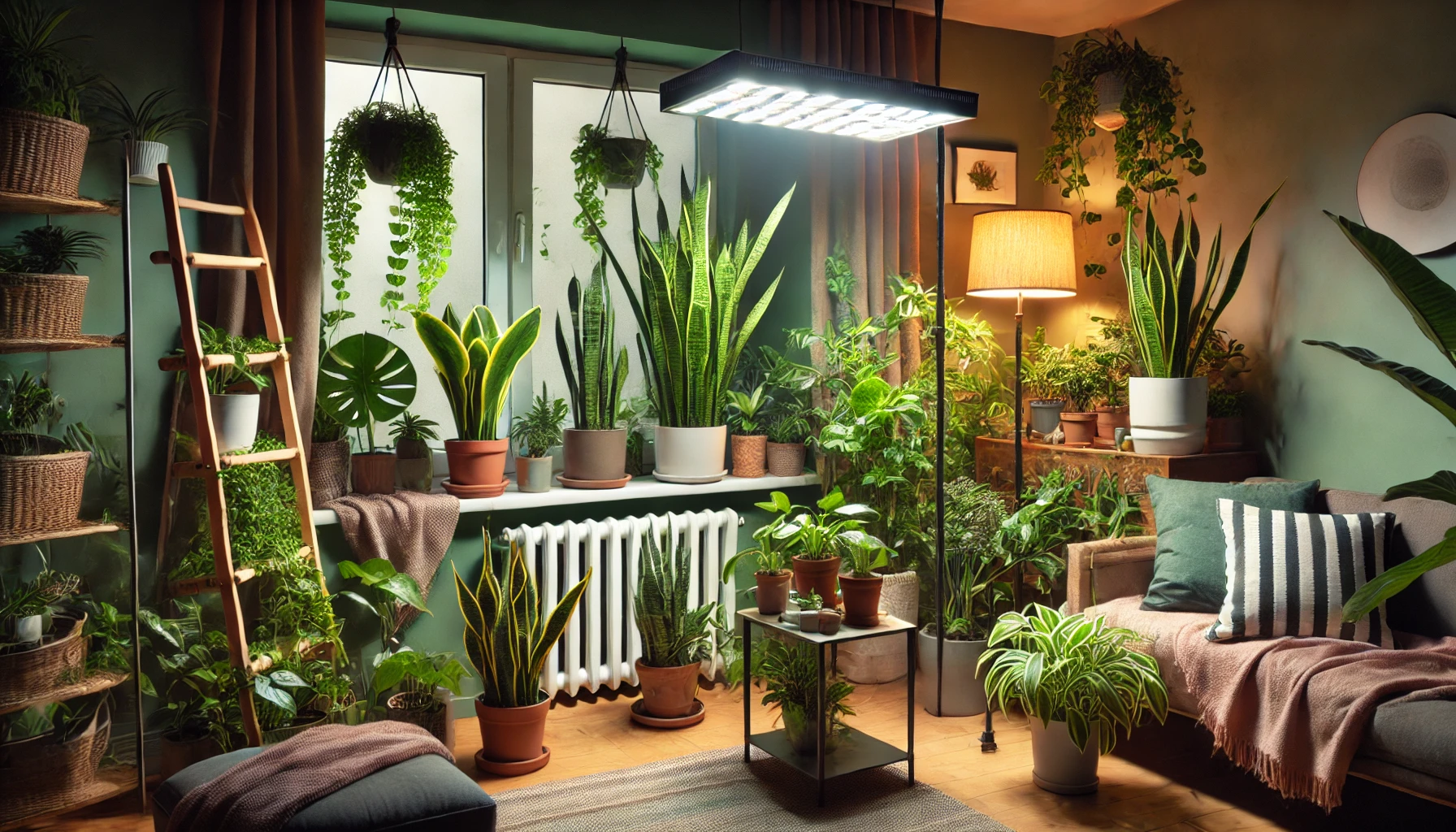
Choose Low-Light Tolerant Plants
Not all plants can handle low light. For best results, choose plants that naturally thrive in shaded conditions. Some excellent options include:
- Snake Plant
- ZZ Plant
- Pothos
- Peace Lily
These plants are known for their ability to adapt and grow in low-light settings.
Use Indirect Light
While your space may lack direct sunlight, you can still optimize available light by placing plants near windows where indirect light filters through. Even low-light plants benefit from a little sunlight, so position them a few feet away from windows for the best results.
Avoid Overwatering
In low-light conditions, plants’ growth slows down, and they require less water. Overwatering can lead to root rot and other problems. Always check the soil moisture before watering, and allow the top inch of soil to dry out between waterings.
Use Grow Lights
If natural light is scarce, invest in grow lights. LED grow lights mimic natural sunlight and provide the spectrum of light that plants need to grow. Place your grow light about 12–18 inches above your plants for optimal results. Use them for 10–12 hours a day to support healthy growth.
Regularly Rotate Your Plants
Since light in low-light environments is usually uneven, it’s important to rotate your plants regularly to ensure all sides receive adequate exposure to light. Rotate your plant every few weeks for balanced growth.
Keep Plants Clean
Dust on leaves can block light from reaching the plant. Regularly wipe down the leaves with a damp cloth to keep them clean and ensure they can absorb as much light as possible.
Fertilize Sparingly
Plants in low light grow slower and require less fertilizer. Use a balanced, diluted fertilizer every 4–6 weeks during the growing season (spring and summer). Over-fertilizing can lead to nutrient burn, especially in low-light conditions.
Ensure Proper Humidity
Low-light environments can sometimes be dry, especially if you have air conditioning or heating running. Increase humidity around your plants by misting them occasionally or placing them in a humidified area. Grouping plants together also helps maintain moisture.
By following these tips, you can create a thriving, healthy environment for your low-light plants. Even in challenging conditions, the right care will ensure that your best plants for first-time plant owners continue to grow and add beauty to your space.
Becoming a successful plant owner, especially with best plants for first-time plant owners, is all about understanding the specific needs of your plants and adjusting your care routine accordingly. By selecting low-maintenance plants, ensuring they get the right amount of light, and using simple care techniques like proper watering and occasional fertilizing, you’ll create an environment where your plants can thrive, even in less-than-ideal conditions.

Remember, patience is key. Plants grow slowly, but with consistent care, your indoor garden will flourish. Whether you’re working with low-light spaces or sunny corners, these steps will help you build a space filled with thriving, vibrant plants. Happy gardening!
Frequently Asked Questions(FAQ)
Can a snake plant thrive in low light?
Yes, snake plants are well-known for their ability to thrive in low-light conditions. They are one of the best plants for areas with minimal sunlight, making them perfect for beginners and those with dim indoor spaces.
How often should I water my snake plant in low light?
In low-light conditions, snake plants require less water since they grow more slowly. Water only when the top inch of the soil is dry. Generally, watering every 2-3 weeks is sufficient, but always check the soil to avoid overwatering.
How much light does a snake plant need?
Snake plants prefer indirect light and can tolerate low light for extended periods. While they can survive in low light, they will grow better with a bit of filtered sunlight. Place your snake plant a few feet away from a window or in a room with ambient light.
Can I keep my snake plant in a completely dark room?
Snake plants need at least some indirect light to survive, so a completely dark room isn’t ideal. While they are tolerant of low light, they still need light to carry out photosynthesis. If your space is very dim, consider using a grow light.
How do I prevent my snake plant from getting leggy in low light?
If your snake plant becomes leggy (long, sparse growth), it may not be getting enough light. To prevent this, move it to a brighter spot or use a grow light to supplement the natural light. Regularly rotating your plant can also help encourage even growth.
Should I fertilize my snake plant in low light?
Fertilizing should be done sparingly. In low-light conditions, the plant’s growth is slower, so it requires less fertilizer. Apply a diluted, balanced fertilizer once every 2-3 months during the growing season (spring and summer).
How do I know if my snake plant is getting too much water?
Overwatering is a common issue with snake plants. If the leaves start turning yellow, soft, or mushy, this may be a sign of root rot due to excess water. Ensure that the soil is completely dry before watering, and always use a pot with drainage.
What’s the ideal temperature for snake plants in low light?
Snake plants do well in temperatures between 60-85°F (15-29°C). Avoid placing them in areas with drafts or extreme temperature fluctuations, as this can stress the plant, especially when growing in low-light conditions.
Can snake plants survive without direct sunlight?
Yes, snake plants can survive without direct sunlight. They thrive in low light but will grow more slowly compared to those placed in brighter spots. For best results, ensure they receive some indirect light, even if it’s just from nearby rooms or a grow light.
How can I help my snake plant grow healthier in low light?
To keep your snake plant healthy in low light, ensure it’s placed in a location where it gets indirect light, water it infrequently, and avoid overwatering. Clean the leaves regularly to allow maximum light absorption and provide occasional fertilizing to support its growth.
